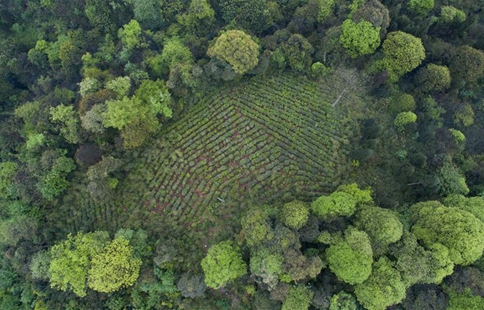WASHINGTON, April 19 (Xinhua) -- For the first time, researchers have captured a clear image of a baby star eating what looks like a dusty "space hamburger."
This new image, captured with the Atacama Large Millimeter/submillimeter Array (ALMA) in Chile and described Wednesday in the U.S. journal Science Advances, confirmed the formation of an accretion disk of gas and dust around a very young star.
"The disk is nearly edge-on and has a radius of about 60 AUs (astronomical unit)," Chin-Fei Lee, a researcher at Taipei-based Academia Sinica Institute of Astronomy and Astrophysics, and colleagues said in a statement.
One astronomical unit is the distance from the Earth to the Sun, or about 150 million kilometers.
"It shows a prominent equatorial dark lane sandwiched between two brighter features, due to relatively low temperature and high optical depth near the disk midplane," they said. "For the first time, this dark lane is seen at submillimeter wavelength, producing a hamburger-shaped appearance."
The new system, named HH212, is in Orion at a distance of about 1,300 light years.
Its central star is only 40,000 years old and has a mass of one fifth of our sun. However, it drives a powerful bipolar jet and thus accretes material efficiently, they researchers said.
Previous search at a resolution of 200 AU only found a flattened envelope spiraling toward the center and a hint of a small dusty disk near the star.
Now with ALMA at a resolution of eight AU, which is 25 times higher, the researchers not only detected but also spatially resolved the dusty disk at submillimeter wavelength.
"It is so amazing to see such a detailed structure of a very young accretion disk," said Lee.
"For many years, astronomers have been searching for accretion disks in the earliest phase of star formation, in order to determine their structure, how they are formed, and how the accretion process takes place.
Now using the ALMA with its full power of resolution, we not only detect an accretion disk but also resolve it, especially its vertical structure, in great detail."
Astronomers have previously thought in the earliest phase of star formation, magnetic fields might slow down the rotation of collapsing material, preventing such a disk from forming around a very young star.
"This new finding implies that the retarding effect of magnetic fields in disk formation may not be as efficient as we thought before," said study co-author Zhi-Yun Li at the University of Virginia.

















